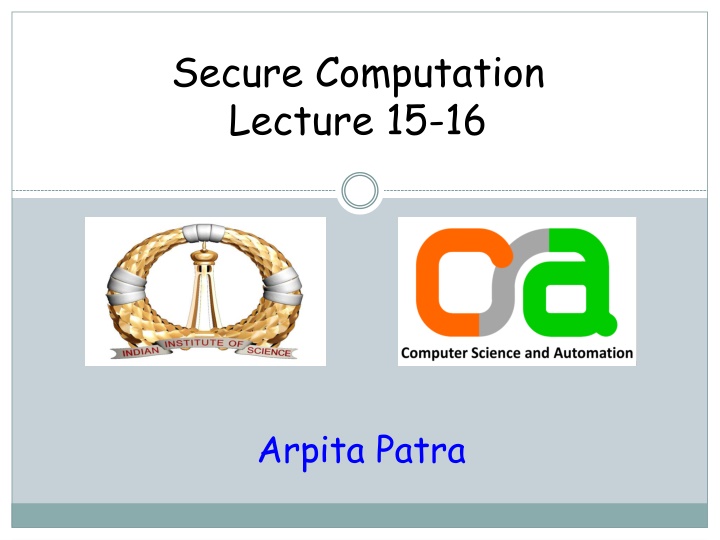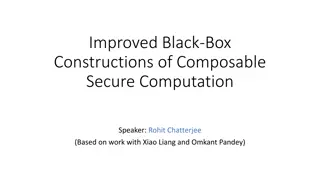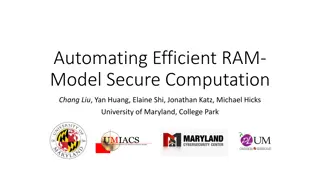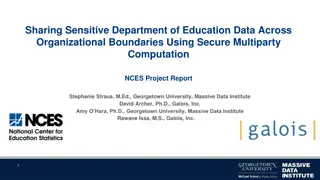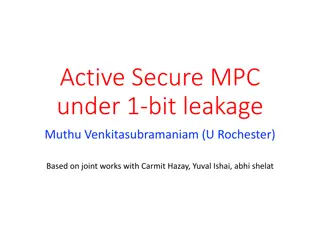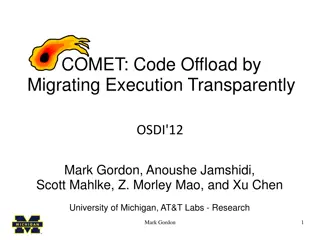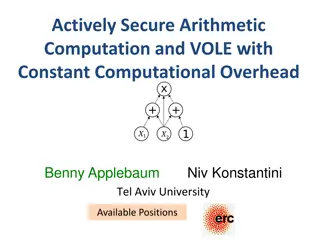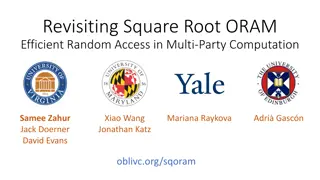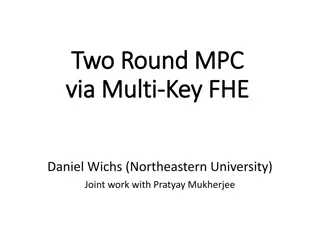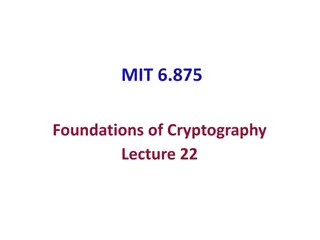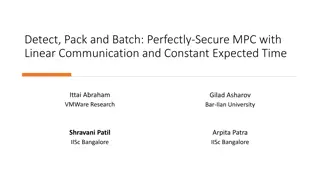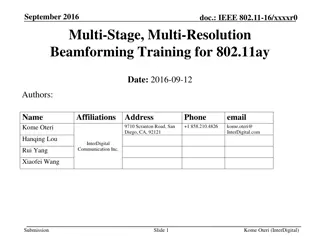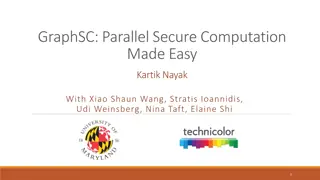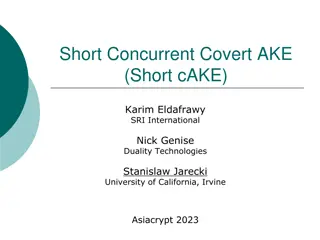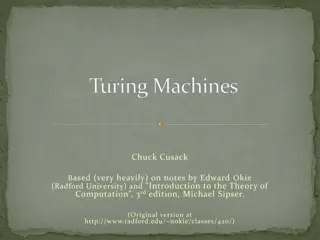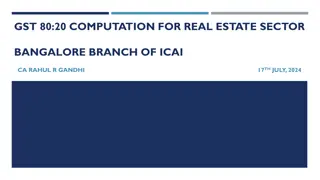Multi-party Computation Fundamentals
Covering concepts of secure computation, from Shamir secret-sharing to advanced protocols like BGW and Yao, exploring MPC with both honest and dishonest majorities, discussing techniques for secure computation with malicious adversaries, and delving into secret sharing and VSS.
Download Presentation

Please find below an Image/Link to download the presentation.
The content on the website is provided AS IS for your information and personal use only. It may not be sold, licensed, or shared on other websites without obtaining consent from the author.If you encounter any issues during the download, it is possible that the publisher has removed the file from their server.
You are allowed to download the files provided on this website for personal or commercial use, subject to the condition that they are used lawfully. All files are the property of their respective owners.
The content on the website is provided AS IS for your information and personal use only. It may not be sold, licensed, or shared on other websites without obtaining consent from the author.
E N D
Presentation Transcript
Secure Computation Lecture 15-16 Arpita Patra
Recap >> i.t MPC with Honest Majority > Shamir Secret-sharing > BGW Protocol based on secret-sharing > Offline/Online phase > Creating offline material and how to use them in online phase (Beaver s trick etc) >> i.t MPC with DisHonest Majority Impossible >> Crypto MPC > OT (from PKE with public-key samplability / Dual-mode Encryption) > GMW (2 and n-party) Protocol from OT and additive secret-sharing > Optimizations of GMW- preprocessing OT, Domain Extension, OT Extension (IKNP/KK13) > Yao Protocol using garbled circuit and OT > Optimazations- point-and-permute, garbled row reduction, Free-XOR > Multi-party Yao i.e. BMR
i.t Multi-party Computation [BGW] 1 5 9 2 1. (n, t)- secret share each input 45 3 3 2. Find (n, t)-sharing of each intermediate value 48 Linear gates: Linearity of Shamir Sharing - Non-Interactive 144 Non-linear gate: Require degree- reduction Technique. Interactive 3. Reconstruct the Shamir-sharing of the output by exchanging shares with each other
Sharing Phase: (n,t) Secret-Sharing Random polynomial of degree t over Fp s.t p>n x1 x2 x3 xn P3 Pn P1 P2
Secret Sharing with Malicious Dealer Verifiable Secret Sharing (VSS) Duality: An honest dealer must pass where a malicious one should fail . Shamir Sharing: Points on a polynomial of degree more than t
Reconstruction Phase: (n,t)-Shamir-sharing P1 x1 P2 x2 Pi P3 x3 Pn xn Lagrange s Interpolation The same is done for all Pi
Reconstruction Phase: (n,t)-Shamir-sharing Malicious At Verifiable Secret Sharing (VSS) handles this too!
Definition of VSS [CGMA85] Extends Secret Sharing to the case of malicious corruption s is secure s is committed Dealer Secret s Sharing Phase vn v1 v3 v2 Reconstruction Phase Secret s
Definition of VSS [CGMA85] Continued.. n parties P = {P1, , Pn}, dealer D (e.g., D = P1) t corrupted parties (possibly including D) At Secrecy If D is honest, then At has no information about secret s during the Sharing phase Correctness If D is honest, then secret s will be correctly reconstructed during reconstruction phase Strong Commitment Corrupted D commits a unique s* - s* should be uniquely reconstructed
SS to VSS SS At is semi-honest Dealer is Honest SS with Cheaters / Honest Dealer VSS At is malicious Dealer is honest VSS At is malicious Dealer may be controlled by At!
i.t Multi-party Computation 1 5 9 2 1. (n, t)- secret share each input 45 3 3 2. Find (n, t)-sharing of each intermediate value 48 Linear gates: Linearity of Shamir Sharing - Non-Interactive 144 Non-linear gate: Require degree- reduction Technique. Interactive 3. Reconstruct the Shamir-sharing of the output by exchanging shares with each other
Secure Multiplication Gate Evaluation x y x y x- j i- j n i(x)= where f(x)= zi i(x) P1 x1 y1 =z1 y1 x1 i C,i j i=1 n n = xy = f(0) = zi i(0) ziri i=1 i=1 P2 y2 x2 x2 y2 =z2 Recombination Vector (r1, ,rn) y3 P3 x3 y3 =z3 x3 xn yn = zn f(x) = f1 (x) f2 (x) of degree 2t Pn yn xn f1 (x) f2 (x)
Secure Multiplication Gate Evaluation x y x y x y P1 x1 y1 =z1 y1 x1 Shamir-share z1 P2 y2 x2 Shamir-share x2 y2 =z2 z2 r1z1 +..+rnzn z3 y3 P3 x3 y3 =z3 x3 Shamir-share zn Shamir-share xn yn = zn f(x) = f1 (x) f2 (x) of degree 2t Pn yn xn f1 (x) f2 (x) Recombination Vector (r1, ,rn)
Secure Multiplication Gate Evaluation x y x y x y P1 x1 y1 =z1 y1 x1 VSS-share z1 P2 y2 x2 VSS-share x2 y2 =z2 z2 r1z1 +..+rnzn z3 y3 P3 x3 y3 =z3 x3 VSS-share zn VSS-share xn yn = zn f(x) = f1 (x) f2 (x) of degree 2t Pn yn xn f1 (x) f2 (x) Recombination Vector (r1, ,rn)
Secure Multiplication Gate Evaluation x y x y z P1 x1 y1 =z1 y1 x1 VSS-share z1 P2 y2 x2 VSS-share x2 y2 =z2 z2 r1z1 +..+rnz n O1: Prevent them in doing this. n 2t+1 z 3 y3 P3 x3 y3 =z3 x3 VSS-share O2: Find a mechanism so that we can correct the errors- n 3t+1 z n VSS-share xn yn = zn f(x) = f1 (x) f2 (x) of degree 2t Pn yn xn f1 (x) f2 (x) Recombination Vector (r1, ,rn)
i.t Multi-party Computation 1 5 9 2 1. (n, t)- secret share each input 45 3 3 2. Find (n, t)-sharing of each intermediate value 48 Linear gates: Linearity of Shamir Sharing - Non-Interactive 144 Non-linear gate: Require degree- reduction Technique. Interactive 3. Reconstruct the Shamir-sharing of the output by exchanging shares with each other VSS with n 3t+1 For perfect security n 3t+1 is necessary and sufficient.
Perfect VSS with n>= 3t+1 Bivariate Polynomial of degree t in x,y as the basis- F(x,y) Univariate Polynomial of degree t in x as the basis f(x) f(0)- secret F(0,0)- secret f(i)- ith share F(x,i) & F(i,y)- ith share t f(i) s will leak NO info about f(0) t F(x,i) s and F(i,y) s will leak NO info about F(0,0) t+1 F(x,i) s (F(i,y) s) will completely determine F(x,y) Lagrange s formula Pi t+1 f(i) s will completely determine f(x) Lagrange s formula Pj F(x,j) F(j,y) F(x,i) F(i,y) Ensure every pair Happy F(j,i) F(j,i) F(i,j) F(i,j)
Perfect VSS with n>= 3t+1 Bivariate Polynomial of degree t in x,y as the basis- F(x,y) Univariate Polynomial of degree t in x as the basis f(x) f(0)- secret F(0,0)- secret f(i)- ith share F(x,i) & F(i,y)- ith share t f(i) s will leak NO info about f(0) t F(x,i) s and F(i,y) s will leak NO info about F(0,0) t+1 F(x,i) s (F(i,y) s) will completely determine F(x,y) Lagrange s formula t+1 f(i) s will completely determine f(x) Lagrange s formula Two random univariate polynomials of degree at most t with the secret F(0,0) as the constants. F(0,y) and F(x,0) Pi has F(0,i) and F(i,0)- Shamir share of F(0,0)
Rest on the board Matrix view of bivariate polynomial Claim: t F(x,i) s and t F(i,y) s will leak NO info about F(0,0). Claim: (t+1) F(x,i) s or (t+1) F(i,y) s completely determines F(x,y). Six round VSS and proof Reducing the number of rounds to four
Feasibility of VSS Round Complexity (Sharing Phase) How big t is compared to n? Adversary (At) Characterization No. of Interaction Polynomially Bounded Adversary n 2t + 1 , t 1 2 Unbounded Adversary and no error allowed n 3t + 1 , t 1 3 Unbounded Adversary and error allowed in reconstruction n 2t+ 1 , t 1 3
Interplay of Round Complexity and Fault tolerance in VSS Adversary (At) Characterization Round Complexity Polynomially Bounded Adversary n 2t + 1 , t 1 2 ASIACRYPT 11 [BKP] t = 1; n 4 1 Unbounded Adversary and no error allowed n 3t + 1 , t 1 3 STOC 01 [GIKT] n 4t + 1 , t 1 2 TCC 06 [FGGRS] t = 1; n 5 1 Unbounded n 2t+ 1 , t 1 3 CRYPTO 09 [PCRR], Unbounded Powerful Adversary Adversary and error allowed in reconstruction n 3t+ 1 , t 1 2 ASIACRYPT 10 [KPR] t = 1; n 4 1
Chalk & Talks CT1 [PCRR09]: The Round Complexity of Verifiable Secret Sharing Revisited http://eprint.iacr.org/2008/172 CT3 [BH08]: Perfectly secure MPC with Linear Communication Complexity. http://cs.au.dk/~vpastro/study_groups/spring_2011/papers/BeeHir08.pdf CT4 [BFO12]: Near-Linear Unconditionally-Secure Multiparty Computation with a Dishonest Minority. http://eprint.iacr.org/2011/629
